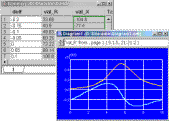|
EDEM (ElectroDynamics of
Elements of
Metal with 3-Dimensional geometry) is designed for
specialists in the field of Applied Electromagnetics. The software allows the possibility of
electromagnetic fields calculations and
investigating the electrodynamical properties of structures which may be represented by
set of perfectly conducting surfaces. Rigorous integral equations and method of moments are used for solving the
problems. |
-
The analyzed objects can be of practically arbitrary shape. For their approximation
polygons, spirals, disks, rings and their sectors, closed and unclosed
surfaces of revolution and cylindrical surfaces, formed by curves
of the second order and two-dimentional splines, and also the surfaces formed by
three-dimensional splines are used.
-
Objects can contain absorbing and impedance films,
lumped capacities and inductances, and also active loads.
|
 |
-
For solving tasks, their symmetry can effectively be used. It allows
significant economy of memory and time of calculations.
For example, when using three degrees of symmetry it is required only
1.5% of a memory size in comparison with the direct solving.
|
|
|
 |
-
For the numerical solution it can be used both constant
approximation, and the basic functions of higher order known as RWG functions.
-
For the solving of systems of linear algebraic equations
both direct and iterative methods are realized, in particular
the Generalized Minimal Residual Algorithm (GMREZ).
-
The analysis of problems for complex structures can be organized on
the basis of a step-by-step method when results of the solving for a
part of structure are used as incident field for other parts.
|
-
The program allows to carry out the solving of tasks series in an
automatic mode and display the results in a graphic and tabulare
form. It releases from tiresome routine work at calculation of
frequency characteristics, etc.
-
The program includes instruments for optimization of researched
structures by the given target criterion. It can be the directed gain of
antenna, etc. For this purpose polyvalent algorithms of functions
extremum seeking are used.
|
 |
|
|
|

EDEM
allows the possibility to determine the density of surface currents on
these structures, near electromagnetic field
prediction, far field pattern calculating, electromagnetic fields and
Pointing's vector shapes constructing, level lines,
magnitude and phase diagrams plotting, total radiating power and
directive gain estimation, phase center and polarization characteristic
determinations, and many other parameters.
|
|
Using the rigorous
equations guarantees that all the physical phenomena that is present in
any system being analyzed is accounted for and high accuracy results
are achieved.
|